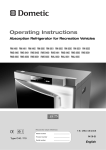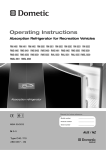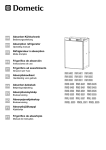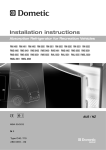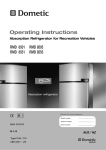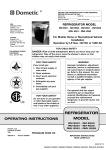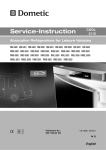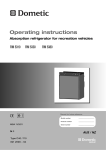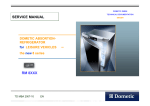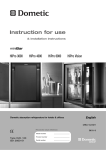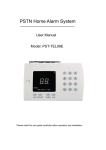Download Dometic RM 8550 Operating instructions
Transcript
Operating Instructions
Absorption Refrigerator for Recreation Vehicles
RM 8400 RM 8401 RM 8405 RM 8500 RM 8501 RM 8505 RM 8550 RM 8551 RM 8555
RMS 8400 RMS 8401 RMS 8405 RMS 8460 RMS 8461 RMS 8465 RMS 8500 RMS 8501
RMS 8505 RMS 8550 RMS 8551 RMS 8555 RML 8550 RML 8551 RML 8555 RMSL 8500
RMSL 8501 RMSL 8505
Record for future reference:
Type C40 / 110
Model number
.............................................
Product number
.............................................
Serial number
.............................................
MBA 06/2010
N 5-1
English
Dometic GmbH
In der Steinwiese 16
D-57074 Siegen
www.dometic.com
© Dometic GmbH - 2007-2010 - Subject to change without prior notice
2
Table of contents
1.0
General . . . . . . . . . . . . . . . . . . . . . . . . . . . . . . . . . . . . . . . . . . . . . .
4
1.1
1.2
1.3
1.4
1.5
1.6
1.7
1.8
1.9
1.10
Introduction . . . . . . . . . . . . . . . . . . . . . . . . . . . . . . . . . . . . . . . . . . . . . . . . . . . . . . . . . . . . . . . .
Guide to these operating instructions . . . . . . . . . . . . . . . . . . . . . . . . . . . . . . . . . . . . . . . . . . . .
Copyright protection . . . . . . . . . . . . . . . . . . . . . . . . . . . . . . . . . . . . . . . . . . . . . . . . . . . . . . . . .
Explanation of symbols used in this manual . . . . . . . . . . . . . . . . . . . . . . . . . . . . . . . . . . . . . . .
Warranty . . . . . . . . . . . . . . . . . . . . . . . . . . . . . . . . . . . . . . . . . . . . . . . . . . . . . . . . . . . . . . . . . . .
Limitation of liability . . . . . . . . . . . . . . . . . . . . . . . . . . . . . . . . . . . . . . . . . . . . . . . . . . . . . . . . . .
Customer services . . . . . . . . . . . . . . . . . . . . . . . . . . . . . . . . . . . . . . . . . . . . . . . . . . . . . . . . . . .
Spare parts . . . . . . . . . . . . . . . . . . . . . . . . . . . . . . . . . . . . . . . . . . . . . . . . . . . . . . . . . . . . . . . . .
Environmental notices . . . . . . . . . . . . . . . . . . . . . . . . . . . . . . . . . . . . . . . . . . . . . . . . . . . . . . . .
Declaration of conformity . . . . . . . . . . . . . . . . . . . . . . . . . . . . . . . . . . . . . . . . . . . . . . . . . . . . . .
4
4
4
4
5
5
5
6
6
6
2.0
Safety instructions . . . . . . . . . . . . . . . . . . . . . . . . . . . . . . . . . . . . . .
7
2.1
2.2
2.3
2.4
2.5
2.6
2.7
Application according to regulations . . . . . . . . . . . . . . . . . . . . . . . . . . . . . . . . . . . . . . . . . . . . .
User's responsibility . . . . . . . . . . . . . . . . . . . . . . . . . . . . . . . . . . . . . . . . . . . . . . . . . . . . . . . . . .
Protection of children when disposing of the equipment . . . . . . . . . . . . . . . . . . . . . . . . . . . . .
Working upon and checking the refrigerator . . . . . . . . . . . . . . . . . . . . . . . . . . . . . . . . . . . . . . .
Information on coolant . . . . . . . . . . . . . . . . . . . . . . . . . . . . . . . . . . . . . . . . . . . . . . . . . . . . . . . .
Operating the refrigerator with gas . . . . . . . . . . . . . . . . . . . . . . . . . . . . . . . . . . . . . . . . . . . . . .
Safety instructions when storing foodstuffs . . . . . . . . . . . . . . . . . . . . . . . . . . . . . . . . . . . . . . .
7
7
7
7
8
8
9
3.0
3.1
3.2
3.3
3.4
4.0
Description of model . . . . . . . . . . . . . . . . . . . . . . . . . . . . . . . . . . . . 10
Model identification . . . . . . . . . . . . . . . . . . . . . . . . . . . . . . . . . . . . . . . . . . . . . . . . . . . . . . . . . .
Refrigerator rating plate . . . . . . . . . . . . . . . . . . . . . . . . . . . . . . . . . . . . . . . . . . . . . . . . . . . . . . .
Technical data . . . . . . . . . . . . . . . . . . . . . . . . . . . . . . . . . . . . . . . . . . . . . . . . . . . . . . . . . . . . . .
Description of refrigerator . . . . . . . . . . . . . . . . . . . . . . . . . . . . . . . . . . . . . . . . . . . . . . . . . . . . .
10
10
11
12
Refrigerator operation . . . . . . . . . . . . . . . . . . . . . . . . . . . . . . . . . . . 13
4.1
4.2
4.3
Cleaning . . . . . . . . . . . . . . . . . . . . . . . . . . . . . . . . . . . . . . . . . . . . . . . . . . . . . . . . . . . . . . . . . . .
Maintenance . . . . . . . . . . . . . . . . . . . . . . . . . . . . . . . . . . . . . . . . . . . . . . . . . . . . . . . . . . . . . . . .
Explanation of operating controls . . . . . . . . . . . . . . . . . . . . . . . . . . . . . . . . . . . . . . . . . . . . . . .
13
13
14
4.3.1
4.3.2
4.3.3
4.3.4
Electrical operation . . . . . . . . . . . . . . . . . . . . . . . . . . . . . . . . . . . . . . . . . . . . . . . . . . . . . . . . . . . . . . . . . . .
Gas operation . . . . . . . . . . . . . . . . . . . . . . . . . . . . . . . . . . . . . . . . . . . . . . . . . . . . . . . . . . . . . . . . . . . . . .
Setting of cooling compartment temperature . . . . . . . . . . . . . . . . . . . . . . . . . . . . . . . . . . . . . . . . . . . . . .
Additional features . . . . . . . . . . . . . . . . . . . . . . . . . . . . . . . . . . . . . . . . . . . . . . . . . . . . . . . . . . . . . . . . . . .
16
17
19
19
4.4
Door locking . . . . . . . . . . . . . . . . . . . . . . . . . . . . . . . . . . . . . . . . . . . . . . . . . . . . . . . . . . . . . . . .
20
4.4.1
4.4.2
Mechanical door lock . . . . . . . . . . . . . . . . . . . . . . . . . . . . . . . . . . . . . . . . . . . . . . . . . . . . . . . . . . . . . . . . .
Fastening and releasing the door lock hook when parking the vehicle . . . . . . . . . . . . . . . . . . . . . . . . . .
20
20
4.5
4.6
4.7
4.8
Lighting . . . . . . . . . . . . . . . . . . . . . . . . . . . . . . . . . . . . . . . . . . . . . . . . . . . . . . . . . . . . . . . . . . . .
Positioning the storage racks . . . . . . . . . . . . . . . . . . . . . . . . . . . . . . . . . . . . . . . . . . . . . . . . . .
Removable freezer compartment . . . . . . . . . . . . . . . . . . . . . . . . . . . . . . . . . . . . . . . . . . . . . . . .
Storing food and making ice cubes . . . . . . . . . . . . . . . . . . . . . . . . . . . . . . . . . . . . . . . . . . . . . .
21
21
21
22
4.8.1
4.8.2
4.8.3
Storing products in the cooling compartment . . . . . . . . . . . . . . . . . . . . . . . . . . . . . . . . . . . . . . . . . . . . . .
Storing products in the freezer compartment . . . . . . . . . . . . . . . . . . . . . . . . . . . . . . . . . . . . . . . . . . . . . .
Making ice cubes . . . . . . . . . . . . . . . . . . . . . . . . . . . . . . . . . . . . . . . . . . . . . . . . . . . . . . . . . . . . . . . . . . . .
22
22
22
4.9
4.10
4.11
4.12
4.13
4.14
Defrosting . . . . . . . . . . . . . . . . . . . . . . . . . . . . . . . . . . . . . . . . . . . . . . . . . . . . . . . . . . . . . . . . . .
Shutting off the refrigerator . . . . . . . . . . . . . . . . . . . . . . . . . . . . . . . . . . . . . . . . . . . . . . . . . . . .
Exchange of the igniter's battery . . . . . . . . . . . . . . . . . . . . . . . . . . . . . . . . . . . . . . . . . . . . . . . .
Winter operation . . . . . . . . . . . . . . . . . . . . . . . . . . . . . . . . . . . . . . . . . . . . . . . . . . . . . . . . . . . . .
Changing the decor panel . . . . . . . . . . . . . . . . . . . . . . . . . . . . . . . . . . . . . . . . . . . . . . . . . . . . .
Information on failure display and trouble-shooting . . . . . . . . . . . . . . . . . . . . . . . . . . . . . . . . .
23
23
24
24
25
26
4.14.1
4.14.2
Status messages on the display . . . . . . . . . . . . . . . . . . . . . . . . . . . . . . . . . . . . . . . . . . . . . . . . . . . . . . . .
roubleshooting . . . . . . . . . . . . . . . . . . . . . . . . . . . . . . . . . . . . . . . . . . . . . . . . . . . . . . . . . . . . . . . . . . . . . .
26
27
3
General
1.0 General
1.1
Introduction
No part of these instructions may be reproduced, copied or utilised in any other way without written authorisation by Dometic GmbH,
Siegen.
You have made an excellent choice in selecting the Dometic Absorption Refrigerator. We
are sure that you will be satisfied with your
new refrigerator in all respects. The refrigerator, which works silently, meets high quality
standards and guarantees the efficient utilisation of resources and energy throughout its
entire life cycle, during manufacture, in use
and when being disposed of.
1.4
Explanation of symbols
used in this manual
Warning notices
1.2
Warning notices are identified by symbols. A
supplementary text gives you an explanation
of the degree of danger.
Guide to these operating
instructions
Observe these warning notices rigorously.
You will thus protect yourself and other
people from injury, and the appliance from
damage.
Before you start using the refrigerator,
please read the operating instructions
carefully.
These instructions provide you with the necessary guidance for the proper use of your refrigerator. Observe in particular the safety
instructions. Observation of the instructions
and handling recommendations is important
for dealing with the refrigerator safely and for
protecting you from injury and the refrigerator
from damage. You must understand what you
have read before you carry out a task.
DANGER!
DANGER indicates an imminent hazardous
situation which, if not avoided, could result in
death or serious injury.
WARNING!
Keep these instructions in a safe place
close to the refrigerator so they may be
referred to at any time.
WARNING indicates a potentially hazardous
situation which, if not avoided, could result in
death or serious injury
CAUTION!
1.3
Copyright protection
CAUTION indicates a potentially hazardous
situation which, if not avoided, may result in
minor or moderate injury.
The information, texts and illustrations in these
instructions are copyright protected and are
subject to industrial property rights.
4
General
CAUTION!
1.6
All information and guidance in these operating instructions were prepared after taking
into consideration the applicable standards
and regulations as well as the current state of
the art. Dometic reserves the right to make
changes at any time which are deemed to be
in the interest of improving the product and
safety.
Dometic will assume no liability for damage in
the case of :
CAUTION (used without the safety alert symbol) indicates a potentially hazardous situation
which, if not avoided, may result in damage to
the appliance.
Information
non-observation of the operating instructions
INFORMATION gives you supplementary and
useful guidance when dealing with your refrigerator.
application not in accordance with the
regulations or provisions
use of non-original spare parts
improper modifications and interferences to
the appliance
Environmental Tips
effect of environmental influences, such as
- temperature fluctuations
- humidity
ENVIRONMENTAL TIPS gives you useful guidance for saving energy and disposal of the
appliance.
1.7
1.5
Limitation of liability
Customer services
Dometic offers a pan-European customer service network. Find your authorised customer
service centre by calling the phone number
indicated in the EuroService Network book,
EuroService Network - which accompanies
every refrigerator. You can also obtain the
address information of the nearest customer
service from www.dometic.com. When contacting Dometic Customer Services, please
state the model, product number and serial
number together with the MLC code, if applicable. You will find this information on the
rating plate inside the refrigerator. We recommend that you note this data in the field provided on the front page of this operation manual.
Warranty
Warranty arrangements are in accordance
with EC Directive 44/1999/CE and the normal
conditions applicable for the country concerned. For warranty or other maintenance, please contact our customer services department.
Any damage due to improper use is not covered by the warranty. The warranty does not
cover any modifications to the appliance or
the use of non-original Dometic parts. The
warranty does not apply if the installation and
operating instructions are not adhered to and
no liability shall be entertained.
5
General
1.8
Energy-saving tips
At an average ambient temperature of
25°C, it is sufficient to operate the refrigerator at middle thermostat setting.
Spare parts
Parts can be ordered throughout Europe from
our customer services.
Where possible, always store precooled
products.
Always give the model and product number
when you contact the customer service! You
will find this information on the rating plate
inside the refrigerator.
Do not expose the refrigerator to direct
sunlight.
Ensure that air circulation of the cooling unit
is not obstructed.
Defrosting at regular intervals saves energy
(see section 4.8 "Defrosting").
Open the refrigerator door only for a short
period of time when removing products.
Run the refrigerator for about 12 hours
before filling it.
1.9
Environmental notices
1.10 Declaration of conformity
Refrigerators manufactured by Dometic
GmbH are free of CFC/HCFC and HFC.
Ammonia (a natural compound of hydrogen
and nitrogen) is used in the cooling unit as a
coolant. Non-ozone-hazardous cyclopentane
is used as a propellant for manufacturing PU
foam insulation.
Disposal
In order to ensure that the recyclable packaging materials are re-used, they should be
sent to the customary local collection system.
The appliance should be transferred to a suitable waste disposal company that will ensure
re-use of the recyclable components and proper disposal of the rest. For eco-friendly draining of the coolant from all absorber refrigeration units, a suitable disposal plant should be
used.
6
Safety instructions
2.0 Safety instructions
2.1
Application according to
regulations
2.3
This refrigerator is designed for installation in
recreation vehicles such as caravans or
motorhomes. The appliance has been typeapproval tested for this application in accordance with the EC Gas Directive.
Protection of children when
disposing of the equipment
WARNING!
When disposing of the refrigerator, detach
all refrigerator doors and leave the storage racks in the refrigerator. In this way
inadvertent entrappment and suffocation
is prevented.
The refrigerator is to be used solely for storing
foodstuffs.
WARNING!
2.4
The refrigerator is not suitable for the proper storage of medication. Please observe in addition the instructions in the medication package inserts.
2.2
Working upon and checking
the refrigerator
WARNING!
Work on gas equipment, exhaust system
and electrical facilities must be carried
out by authorised personnel only.
Substantial damage to property and/or
injury to persons can arise through unprofessional procedures.
User's responsibility
Anyone operating the refrigerator must be
familiar with the safe handling and understand
the advice in these operating instructions.
This appliance is not intended for use by persons (including children) with reduced physical, sensory or mental capabilities, or lack of
experience and knowledge, unless they are
supervised or have been given instruction
concerning use of the appliance by a person
responsible for their safety. Children should be
supervised to ensure that they do not play with
the appliance. Cleaning and user maintenance
shall not be made by children.
[EN 60335-2-24, 7.12]
DANGER!
Never use an unshielded flame to check
gas bearing parts and pipes for leakage!
There is a danger of fire or explosion.
WARNING!
Never open the absorber cooling unit! It is
under high pressure.
There is a danger of injury!
7
Safety instructions
2.5
2.6
Information on coolant
Ammonia is used as a coolant.
This is a natural compound also used in household cleaning agents (1 litre of Salmiak
cleaner contains up to 200g of ammonia about twice as much as is used in the refrigerator). Sodium chromate is used for corrosion
protection (1.8% by weight of the solvent).
Operating the refrigerator
with gas
It is imperative that the operating pressure
corresponds to the data specified on the
rating plate of the appliance. Compare the
operating pressure of the rating plate with the
data specified on the pressure reducing valve
of the liquid gas cylinder.
In the event of leakage (easily identifiable from
the strong odour), proceed as follows:
- Switch off the appliance.
- Air the room thoroughly.
- Inform authorised customer services.
WARNING!
Operating the appliance with gas is
not permitted
at petrol stations
on ferry boats
while transporting the caravan/motorhome by a transporter or breakdown
vehicle.
For your safety it was ascertained in an
expert's report that no impairment of health
exists when the coolant is discharged.
There is the danger of fire!
Leave the equipment switched off.
8
Safety instructions
2.7
Regularly clean the inside of the refrigerator.
Safety instructions when storing foodstuffs
Please observe the instructions and information regarding the use-by date on the outside
packaging of the food.
Instructions for storing food in a refrigerator:
No refrigerator of any kind can improve the
quality of the food; refrigerators can only
maintain the food's quality for a short duration as from the time of storing it.
Please observe the following particular
conditions for storing food in a refrigerator
that is built into a vehicle:
Please observe section "4.1 Cleaning" of this
instruction.
A change in the climatic conditions such as
temperature fluctuations
High temperatures inside the vehicle when
it is closed and parked in direct sunlight
(temperatures are possible up to 50°C)
Use of the refrigerator during travel with the
power supply of 12V DC
A refrigerator built in behind a window and
exposed to direct sunlight
Storing the products too soon, i.e. shortly
after starting up the appliance for use
Under these particular conditions the refrigerator cannot guarantee reaching the temperature needed for perishables.
Perishables include all products with a stipulated use-by date and a minimum storage temperature of +4°C or less, especially for meat,
poultry, fish, sausages, pre-packed foods.
Pack raw and cooked foods separately
(e.g. in containers, aluminium foil, etc.).
Only remove the outside packaging of
single packs if all the necessary information, e.g. the use-by date, can also be read
on the single packs.
Do not leave cooled goods outside the
refrigerator for too long.
Place the foods with the next use-by date
at the front, accordingly.
Pack away any left-over food and eat at the
first opportunity.
Wash your hands before and after handling
any food.
9
Description of model
3.0 Description of model
3.1
3.2
Model identification
Refrigerator rating plate
Example :
The rating plate is to be found on the inside of
the refrigerator. It contains all important details
of the refrigerator. You can read off from this
the model identification, the product number
and the serial number. You will need these
details whenever you contact the customer
service centre or when ordering spare parts.
RM (S) (L) 8 4 0 0
1
5
Depth:
0 = Standard
5 = + 55mm
6 = + 65mm
4 = Width 486mm
5 = Width 525mm
1
2
3
Model range
„Large“
4
5
Stepped cabinet
Refrigerator Mobile /
Mobile Absorption Refrigerator
Fig. 1
0 = manual energy selection + manual ignition (battery igniter)
1
Model number
2
Product number
3
Serial number
4
Electrical rating details
5
Gas pressure
1 = manual energy selection, automatic ignition (MES)
5 = automatic and manual energy selection,
automatic ignition (AES)
Dometic refrigerators are equipped for a connection pressure of 30 mbar. For connection
to a 50 mbar gas system, use Truma VDR
50/30 medium pressure controller.
10
Description of model
3.3
Technical data
RMS 8xxx
RML 8xxx
RM 8xxx
H
T
B
Fig. 2
Model
Fig. 3
Dimensions
Gross capacity
H x W x D (mm) with
without
Depth incl. door
freezer compartment
Rating details
mains/battery
Consumption *
electricity/gas
over 24hrs
Fig. 4
Net
weight
Ignition
Piezo Automat
RMS 8400
821x486x568
80 / 8 lit.
85 lit.
125 W / 120 W
ca.2,5 KWh / 270 g
25 kg
RMS 8401
821x486x568
80 / 8 lit.
85 lit.
125 W / 120 W
ca.2,5 KWh / 270 g
25 kg
821x486x568
80 / 8 lit.
85 lit.
125 W / 120 W
ca.2,5 KWh / 270 g
25 kg
RM 8400
821x486x568
90 / 8 lit.
95 lit.
135 W / 130 W
ca.2,4 KWh / 270 g
27 kg
RM 8401
821x486x568
90 / 8 lit.
95 lit.
135 W / 130 W
ca.2,4 KWh / 270 g
27 kg
RM 8405
821x486x568
90 / 8 lit.
95 lit.
135 W / 130 W
ca.2,4 KWh / 270 g
27 kg
RMS 8460
821x486x633
90 / 11 lit.
96 lit.
125 W / 120 W
ca.2,5 KWh / 270 g
26 kg
RMS 8461
821x486x633
90 / 11 lit.
96 lit.
125 W / 120 W
ca.2,5 KWh / 270 g
26 kg
RMS 8465
821x486x633
90 / 11 lit.
96 lit.
125 W / 120 W
ca.2,5 KWh / 270 g
26 kg
RMS 8500
821x523x568
90 / 9 lit.
96 lit.
125 W / 120 W
ca.2,5 KWh / 270 g
26 kg
RMS 8501
821x523x568
90 / 9 lit.
96 lit.
125 W / 120 W
ca.2,5 KWh / 270 g
26 kg
RMS 8505
821x523x568
90 / 9 lit.
96 lit.
125 W / 120 W
ca.2,5 KWh / 270 g
26 kg
RMS 8550
821x523x623 103 /12 lit.
821x523x623 103 /12 lit.
110 lit.
125 W / 120 W
ca.2,6 KWh / 270 g
27 kg
110 lit.
125 W / 120 W
ca.2,6 KWh / 270 g
27 kg
110 lit.
125 W / 120 W
ca.2,6 KWh / 270 g
27 kg
RM 8500
821x523x623 103 /12 lit.
821x523x568 100 / 9 lit.
106 lit.
135 W / 130 W
ca.2,4 KWh / 270 g
28 kg
RM 8501
821x523x568
100 / 9 lit.
106 lit.
135 W / 130 W
ca.2,4 KWh / 270 g
28 kg
RM 8505
821x523x568
100 / 9 lit.
106 lit.
135 W / 130 W
ca.2,4 KWh / 270 g
28 kg
RM 8550
821x523x623 115 /12 lit.
821x523x623 115 /12 lit.
122 lit.
135 W / 130 W
ca.2,6 KWh / 270 g
30 kg
122 lit.
135 W / 130 W
ca.2,6 KWh / 270 g
30 kg
821x523x623 115 /12 lit.
1245x525x625 179 /33 lit.
122 lit.
135 W / 130 W
ca.2,6 KWh / 270 g
30 kg
189 lit.
190 W / 170 W
ca.3,2 KWh / 380 g
45 kg
1245x525x625 179 /33 lit.
1245x525x625 179 /33 lit.
189 lit.
190 W / 170 W
ca.3,2 KWh / 380 g
45 kg
189 lit.
190 W / 170 W
ca.3,2 KWh / 380 g
45 kg
155 lit.
190 W / 170 W
ca.3,2 KWh / 380 g
40 kg
RMSL 8551
1245x525x625 145 /28 lit.
1245x525x625 145 /28 lit.
155 lit.
190 W / 170 W
ca.3,2 KWh / 380 g
40 kg
•
RMSL 8555
1245x525x625 145 /28 lit.
155 lit.
190 W / 170 W
ca.3,2 KWh / 380 g
40 kg
•
RMS 8405
RMS 8551
RMS 8555
RM 8551
RM 8555
RML 8550
RML 8551
RML 8555
RMSL 8550
Subject to technical changes.
*Average consumption measured at an average ambient
temperature of 25°C in pursuance of ISO Standard.
11
•
•
•
•
•
•
•
•
•
•
•
•
•
•
•
•
•
•
•
•
•
•
•
•
•
Description of model
3.4
Description of refrigerator
1
2
8
3
4
5
6
9
7
Fig. 5
1
Operating controls
2
Door locking button
3
Freezer compartment (removable)
4
Insertable grid shelf (available as option, to be used when freezer compartment is removed)
5
Post-evaporator for cooling compartment
6
Condensation water drain channel
7
Vegetable bin
8
Upper door shelf with flap, egg shelf available as option may be inserted
9
Lower door shelf with bottle holders
12
Refrigerator operation
4.0 Refrigerator operation
4.2
In compliance with the applicable regulations, please note that the gas unit and the
connected ventilation ducts must be checked by authorised technical personnel after
first use and after every other year for compliance with the European Standard EN
1949. A test certificate has to be issued. It is
the user's responsibility to arrange this
test.
The refrigerator is equipped to operate on
three power modes:
Mains voltage (230V AC)
Direct-current voltage (12V DC)
Gas (liquid gas propane/butane)
Select the desired power mode by the energy
selector switch (battery igniter type models)
or the MODE button (MES, AES). Appliances
with automatic energy selection (AES) are
additionally provided with "automatic mode"
function. The AES system automatically
selects the best energy source for each particular situation.
4.1
Maintenance
The gas burner must be inspected and
cleaned as necessary at least once a year.
When using liquefied petroleum gas (tank
or refill cylinders) the maintenance interval
is reduced to half-yearly or quarterly.
Keep the evidence of maintenance work carried out on your refrigerator.
Work on gas and electrical equipment
shall be carried out by qualified personnel
only.
Cleaning
Before starting up the refrigerator, it is recommended that you clean it inside and repeat this
at regular intervals.
Use a soft cloth and lukewarm water with a mild
detergent. Then wipe out the appliance with
clean water and dry thoroughly.
Fig. 6
To avoid material alterations, do not use soap or
hard, abrasive or soda-based cleaning agents.
Do not allow the door seal to come into contact
with oil or grease.
13
It is recommended that this is carried out by
an authorised customer services department.
We recommend maintenance following an extended shutdown of the vehicle. Please contact our
customer services.
Refrigerator operation
4.3
Explanation of operating
controls
Manual energy selection / manual ignition (RM 8xx0) battery igniter:
1
2
3
4
Fig. 8
11
22
33
44
=
=
=
=
Power On switch / Energy selector switch
Temperature controller
Battery igniter (gas)
Flame indicator (galvanometer)
Explanations:
The refrigerator is equipped to operate on
mains power, 12V DC or liquid gas. Select the
desired power supply by turning the energy
selector switch "1". The energy selector
switch "1" has four settings:
Off
Mains voltage (230V AC)
Direct-current voltage (Batterie, 12V DC)
Gas (liquid gas propane/butane)
1
Aus
230V~
12VGas
Fig. 9
14
Refrigerator operation
Manual energy selection / automatic ignition (RM 8xx1) MES:
1
2
Mode
3
4
5
6
Fig. 9
Automatic energy selection / automatic ignition (RM 8xx5) AES:
1
2
Mode
3
4
5
6
Fig. 10
11
22
33
44
55
66
=
=
=
=
=
=
Power On switch / Energy selector switch (MODE)
Temperature selection
Indicator LED failure
Indicator LED door lock (optional)
Indicator-LED / operating mode display
Temperature level display
Explanations:
Switch the refrigerator ON or OFF by pressing
button "1" for 3 seconds.
Button "1" allows you to either initiate the
requested energy supply or activate dimming
of the LED brightness. By pushing once, the
indicators illuminate for 10 seconds.
Button "3" and indicator "5" constitute an
optional feature available with refrigerators
equipped with electrical door locking (see also
section 5.3 Door lock).
15
Refrigerator operation
4.3.1 Electrical operation
AES Appliances (automatic energy selection)
Appliances with battery igniter
(manual energy selection)
11
Mode
1
6
Fig. 15
Fig. 12
Fig. 11
Switch on the appliance by turning the energy
selection switch "1" clockwise to position :
230V operation,
12V operation.
Fig. 16
To start the refrigerator, press button "1" for 3
seconds.
The previously selected operating mode is displayed, e.g. 230 which means 230V .
By pressing button "1" again, you may change
the operating modes to:
AES (automatic energy selection)
230V,12V, GAS (manual energy selection)
CAUTION !
The refrigerator should only be used in
12VDC-operation while the vehicle’s engine
is running, otherwise the on-board-battery
would be discharged within a few hours!
Upon switching on, the electronics automatically selects one of the three possible energy
types: 230V - 12V - liquid gas. The control electronics automatically ensures that the refrigerator is supplied with the optimum source of energy in each respective case.
MES Appliances (manual energy selection)
Sequence of priority: 1.)
2.)
3.)
4.)
11
Mode
Solar (12V -)
230V ~
12V Liquid gas
66
Fig. 13
To start the refrigerator, press button "1" for 3
seconds.
The LED "6" of the previously selected operating mode illuminates:
,
or
.
230V
12V
GAS
Change the operating mode by pressing button
"1" again. The appropriate indicator LED will
illuminate.
16
If sufficient mains voltage is available (more than
195 V), this power source is selected as prime
option. If a solar system capable of powering
the refrigerator is installed, the solar 12V supply
takes priority.
The 12V operation is otherwise only effective
while the engine is running. The appliance
electronic system features a low-voltage
mechanism. Once the voltage drops below
10.5V, the appliance shuts down (manual
mode) or switches over to a different energy
source (AES mode).
Refrigerator operation
4.3.2 Gas operation (Liquid gas)
Appliances with battery igniter
The refrigerator must be operated using
liquid gas (propane, butane) (no natural gas
or town gas). When using LPG gas, please
consider that the burner needs cleaning at
shorter intervals due to the gas combustion
method (2 - 3 times per year recommended
In Europe, gas operation is permitted while
travelling only on the condition that the gas
system of the vehicle is equipped with a hose
rupture protection. The national regulations
of the respective country must be observed.
For physical reasons, gas ignition faults
could occur starting from an altitude above
sea level of approx. 3280 ft. / 1000 m (No
malfunction!)
On the initial refrigerator start-up or after a
cylinder change, air may be trapped in the
gas line. To purge the air from the lines,
switch on the refrigerator and any other gas
appliances (e.g. stove) for a short time. The
gas ignites without delay.
11
22
1. Turn the rotary selector switch "1" to
position
.
2. Turn the temperature selector "2" clockwise
and push. Keep the controller button depressed.
33
44
Fig. 19
WARNING!
As a basic rule, gas operation is prohibited in petrol stations
Prior to starting the refrigerator in gas
mode :
Open the gas cylinder valve.
Open the shut-off valve for gas supply to the
refrigerator.
Fig. 18
Fig. 17
Fig. 20
3. Then, press knob "3" of battery igniter down
and keep it depressed. The ignition process
is activated automatically.
4. Once the flame ignites, the pointer of galvanometer "4" begins moving into the green
range. The refrigerator is operational. Keep
knob "2" depressed for approx. 15 seconds
and finally release it.
Each refrigerator with manual ignition is equipped with an automatic flame safety valve which
interrupts the gas supply automatically after
approx. 30 seconds when the flame has extinguished.
17
Refrigerator operation
MES Appliances
AES Appliances
1
1
Mode
Mode
F
6
Fig. 21
6
Fig. 22
Fig. 24
Fig. 23
1. Press button "1" several times until the indicator LED "6"
illuminates.
Press button "1" several times until the indicator LED "6" GAS illuminates.
2. The ignition process is activated automatically by means of an automatic igniter.
The device is now in manual gas mode. When
you select the automatic mode (the display
shows AES), GAS is only selected as energy
option according to the sequence of priority
when none of the two electrical types of power
supply is available.
The ignition system will make 2 ignition attempts
with 25 seconds interval when the burner fails to
light. If repeated attempts fail to start the operation, a fault is indicated (please refer to failure
indication).
66
6
Fig. 25
Fig. 26
In automatic mode, AES and the currently used
type of power supply (e.g. GAS) are indicated
alternately.
Switching over to a manual energy selection is
possible at any time.
18
Refrigerator operation
Refuelling while in AES mode operation
In order to prevent unintended switching to gas
operation during refuelling, the electronic
system starts gas operation of the refrigerator
after the motor has been turned off for 15 minutes. During this period the appliance is ready for
operation ("stand-by"). In automatic mode the
"AES" indication only is illuminated.
WARNING!
The use of unshielded flames is prohibited
in petrol station environments.
Should the refuelling stop last longer than
15 minutes, the refrigerator has to be switched off or switched over to another energy
type.
4.3.3 Setting of cooling compartment
temperature
The cooling unit's performance is influenced by
ambient temperatures. Please select the medium setting for ambient temperatures between
+15°C and +25°C (refer to Fig. 28, temperature
level 3). The unit operates within its optimum
performance range.
Dometic refrigerators work according to the
absorption principle. For physical reasons, an
absorption system responds slowly to changes
made by the thermostat controller, by loss of
cooling energy through opening the door or
during storing food. The devices meet the cooling performance requirements of the Climatic
Class SN acc. to EN/ISO 7371 in the temperature range of +10°C to +32°C ambient temperature.
For temperatures below +10°C, winter
covers should be installed. For ambient temperatures exceeding +32°C for a longer
period of time, it is recommended installing
Dometic additional fan (item no. 241 2985 00 ).
4.3.4 Additional features (MES and AES)
The brightness of the display reduces after a
few seconds if no other buttons are pressed.
22
If the door is open, the interior lighting is switched off automatically after 2 minutes.
Failures are indicated by flashing of the failure indicator LED.
77
Fig. 26
Select the desired cooling compartment temperature by pressing button "2".
The LED display "7" of the selected temperature setting is illuminated.
The scale starts with MIN position at the bottom
LED position (small crystal = highest temperature) and climbs up to MAX position at the upper
LED position (large crystal = lowest temperature). Note: The temperature levels do not relate to
absolute temperature values.
19
AES-Models : Should the door be kept open
for too long (more than 2 minutes), an
acoustic signal is initiated (pulsing whistle
tone).
AES-Models : Should the electronic control
detect any failure, an acoustic signal will
sound (pulsing whistle tone). At the same
time the display starts flashing (for troubleshooting, please refer to section 4.12).
Refrigerator operation
4.4
Door locking
4.4.2 Fastening and releasing the door
lock hook when parking the vehicle
If the vehicle is parked for a longer period of
time, the locking hook may be clamped by
means of a lockbar. The door may now be opened by just pulling it without need of pressing
the locking button.
CAUTION!
As a basic rule, shut and lock the refrigerator before you start your journey!
4.4.1 Mechanical door lock
Fig. 27
Fig. 28
Open the door by pressing the locking button
and pull open (see Fig. 28).
Shut the door again by pushing it to close. The
snapping into the lock can be heard.
While the vehicle is parked, the locking hook
may be fixed to facilitate opening of the door
(Fig. 29-32).
Fig. 29-32
20
Refrigerator operation
4.5
Lighting
4.7 Removable freezer compartment
If the door is open for more than 2 minutes, the
sensor-controlled interior lighting is automatically cut off (except for models with battery
igniter).
AES-Models : Should the door be kept open
more than 2 minutes, an acoustic signal is initiated (pulsing whistle tone).
Fig. 35
To enlarge the cooling compartment, just remove the freezer compartment.
1. Unlock the freezer compartment on both
sides.
2. Pull the freezer compartment out.
Fig. 33
Please contact the authorized Dometic Service
if a failure occurs.
Store the freezer compartment safely in order to
prevent damage
Once the freezer compartment is removed, an
additional storage rack (3.) may be installed. The
storage rack is a piece of extra equipment and
may be obtained by Dometic.
4.6
Positioning the storage racks
Fig. 34
The storage racks may be pulled out by
smoothly lifting them and may be positioned as
desired.
21
Refrigerator operation
4.8
Storing food and making ice
cubes
4.8.2 Storing products in the freezer
compartment
Do not keep carbonated drinks in the freezer.
The freezer compartment is suitable for
making ice cubes and for short-term storage
of frozen food. It is not suitable as a means of
freezing foods.#
4.8.1 Storing products in the cooling
compartment
Switch the refrigerator on approx. 12 hours
before filling it.
Always store pre-cooled foods in the refrigerator. Make sure that the food is well cooled
when it is bought and also when transporting
it. Use insulated cooling bags.
Open the refrigerator door only for a short
period of time when removing products.
Products must be packed - best of all in closed containers, wrapped in aluminium foil or
similar - and stored separately from each
other, in order to prevent drying out or
odours.
When ambient temperatures are lower than
+10°C and the refrigerator is exposed to
these temperatures for extended periods of
time, an even regulation of freezer temperature cannot be guaranteed for system-related reasons. This can cause the temperature
in the freezer to rise and the stored goods to
melt.
Allow foods that have been warmed up to
cool down before storing.
Avoid storing products in the refrigerator that
could emit volatile flammable gases.
4.7.3 Making ice cubes
Do not expose the refrigerator to direct sun
light. Please bear in mind that the temperature inside a closed vehicle increases sharply if
exposed to sunlight and that this can reduce
the efficiency of the refrigerator.
Ice cubes are best frozen overnight. At night,
the refrigerator has less work to do and the unit
has more reserves.
1. Fill the ice cube tray
with drinking water.
Ensure that air circulation of the cooling unit
is not obstructed. Keep the ventilation grilles
free from obstructions.
Fig. 36
2. Place the ice cube
tray in the freezer
compartment.
Fig. 37
WARNING!
Only use drinking water!
22
Refrigerator operation
4.9
Defrosting
4.10 Shutting off the refrigerator
As time goes by, frost builds up on the fins
inside the refrigerator. A layer of frost thicker on
one side may occur and does not represent a
malfunction. When this layer of frost is about 3
mm thick, the refrigerator should be defrosted.
Switch off the refrigerator, as described in
section 4.9 Shutting of the refrigerator.
1
2
Mode
Fig. 39
Fig. 40
Fig. 41
Fig. 42
Remove all food and the ice cube tray.
Leave the refrigerator door open to allow air
to enter and to prevent formation of mildew.
After defrosting (freezer compartment and
fins free of frost), wipe both cooling compartments dry with a cloth.
Note: Water thawing in the main compartment
of the refrigerator runs into an appropriate container at the back of the refrigerator. From there,
the water evaporates.
For battery igniter models, set energy selector
switch "1" to position "OFF". The appliance is
switched off (Fig. 39).
Press the "MODE" button to switch off MES
and AES models. Keep button "2" pressed for
3 seconds. The display disappears and the
appliance is fully switched off (Fig. 40).
CAUTION!
Release the locking mechanism of the door
lock by pushing it and shift it to the front. If the
door is shut in this position, a small gap is
nevertheless kept open to prevent formation
of mildew.
The layer of ice must never be removed forcibly, nor may defrosting be accelerated
using a heat source!
If the refrigerator is to be taken out of service
for an extended period of time, close the onboard shut-off valve and the cylinder valve .
Fig. 38
23
Refrigerator operation
4.11 Exchange of the igniter's battery
4.12 Winter operation
1
1
Fig. 45
Fig. 43
Unlock the battery by depressing and turning
the button (C) approx. 90° clockwise. Remove
cap and exchange battery (1.5V AAA / R3 /
Micro).
In winter, check that the ventilation grilles and
the exhaust duct system (1) have not been
blocked by snow, leaves, etc..
2
2
Observe correct
polarity!
Fig. 46
Fig. 44
When the outside temperature falls below
+10°C, the winter cover should be fitted. This
protects the unit from excessively cold air which
could have adverse effects on the performance
of the unit
You should also attach the winter cover if the
vehicle is taken out of service for a longer period
of time or while it is being cleaned from the outside
24
Refrigerator operation
4.13 Changing the decor panel
Model RM(S)L 8xxx
Model RM 8xxx, RMS 8xxx
Remove the lateral ledge (1) the door
(ledge is attached, not screwed).
Shift decor panel (2) away from the door
and insert the new decor panel. Re-attach
ledge (1) .
Fig. 49
2
Fig.48
1
VORSICHT!
Fig. 47
Decor panel dimensions :
Casing width
486 mm
Height
Width
743 +/- 0.5 mm
472 +/- 0.5 mm
Casing width
523 mm
Height
Width
743 +/- 0.5 mm
510,5 +0/- 1 mm max. 2.2 mm
Thickness
Fig.51
Fig. 50
max. 2.2 mm
Thickness
Decor panel dimensions :
Casing width
525 mm
Height
Width
Thickness
1169,5 +0/-1 mm 507,5 +0/-1 mm max. 1.7 mm
25
Refrigerator operation
4.14 Information on failure display
and trouble-shooting
Refrigerators with an electronics system
(MES, AES) indicate the occurence of a malfunction by the LED or display flashing.
If a malfunction occurs, the indicator LED
"Failure" (1) flashes simultaneously. In the
case of AES models an acoustic alarm
sounds.
4.14.1 Status messages on the display
11
1
33
33
2
2
Fig. 52
11= Indicator LED failure
22= Operating mode display
33= Temperature level display
Failure :
Display :
MES
Fig. 53
AES
LED is flashing
"230" is flashing
230V mode: "230V" not available or voltage too
low
LED is flashing
"12" is flashing
12V mode: "12V" not available or voltage too low
LED is flashing
"GAS" is flashing
GAS/Auto mode: Flame not ignited
All temperature setting
LEDs are flashing
Temperature sensor defective, refrigerator works
on mid temperature setting
LED + all temperature setting
LEDs are flashing
"HE1" is flashing
230V - Heating element defective
LED + all temperature setting
LEDs are flashing
"HE2" is flashing
12V - Heating element defective
All temperature setting
LEDs are flashing
26
Refrigerator operation
4.14.2 Troubleshooting
Before notifying the authorised Service Center,
please check whether:
the instructions in section "Operating the
refrigerator" have been observed.
the refrigerator stands level.
it is possible to operate the refrigerator with
any available power source.
Failure: The refrigerator does not cool sufficiently.
Possible cause
Action you can take
Inadequate ventilation to the unit.
Check that the ventilation grilles are not covered.
Thermostat setting is too low.
Set thermostat to a higher level.
The condenser is heavily frosted.
Check that the refrigerator door closes properly.
Too much warm food has been stored inside within
short period of time.
Allow warm food to cool down before storage.
The appliance has been running for only a short period
of time.
Check whether the cooling compartment works after
approx. 4 - 5 hours.
Ambient temperatures too high.
Regularly remove ventilation grilles.
Failure: The refrigerator does not cool in gas operation mode.
Possible cause
Action you can take
Gas cylinder empty.
Change gas cylinder.
Is the upstream shut-off device open ?
Open shut-off device.
Air in the gas pipe ?
Switch off the appliance and start again. Repeat this
procedure 3 - 4 times, if necessary.
Failure: The refrigerator does not cool in 12V operation.
Possible cause
Action you can take
On-board fuse defective.
Fit new fuse.
On-board battery discharged.
Check battery, charge it.
Engine not running.
Start engine.
Heating element defective (please also refer to failure
indication).
Please inform the Dometic Customer Services.
Failure: The refrigerator does not cool in 230V operation.
Possible cause
Action you can take
On-board fuse defective.
Fit new fuse.
Vehicle not connected to mains supply voltage.
Make a connection to a mains power supply.
AES: Gas operation despite connection to the mains
supply voltage?
Appliance switches to gas operation due to insufficient
mains supply voltage (automatically switches back to
230V operation).
Heating element defective (please also refer to failure
indication).
Please inform the Dometic Customer Services.
27
www.dometic.com




























